"Green infrastructure uses vegetation, soils, and other elements and practices to restore some of the natural processes required to manage water and create healthier urban environments. At the city or county scale, green infrastructure is a patchwork of natural areas that provides habitat, flood protection, cleaner air, and cleaner water. At the neighborhood or site scale, stormwater management systems that mimic nature soak up and store water (US Environemntal Protection Agency 2016)."[i]
Low impact development (LID) refers to practices that use or mimic natural processes that result in the infiltration, evapotranspiration or use of stormwater in order to protect water quality and aquatic habitat. Best Management Practices (BMPs) refer to specific strategies that contribute to these ends, such as swales, rainwater harvesting, or permeable surfaces. BMPs which treat small areas (rather than relying on large centralized structures) are the building blocks of green infrastructure.
It is estimated that a “Low Impact Development” ordinance requiring Green infrastructure best management practices for development and redevelopment could reduce stormwater flows in the Los Angeles basin by 20-30%.[ii] Some of the most important benefits of green infrastructure, however, go far beyond stormwater management. Not only do trees and other plants collectively reduce temperatures in overheated cities, but we also know now that exposure to nature helps people feel better[iii], learn and focus more effectively[iv], recover faster[v], and work together better around nature. In short, we are healthier, happier, and better people when exposed to nature.
gi curb cut how it works sueellen 01
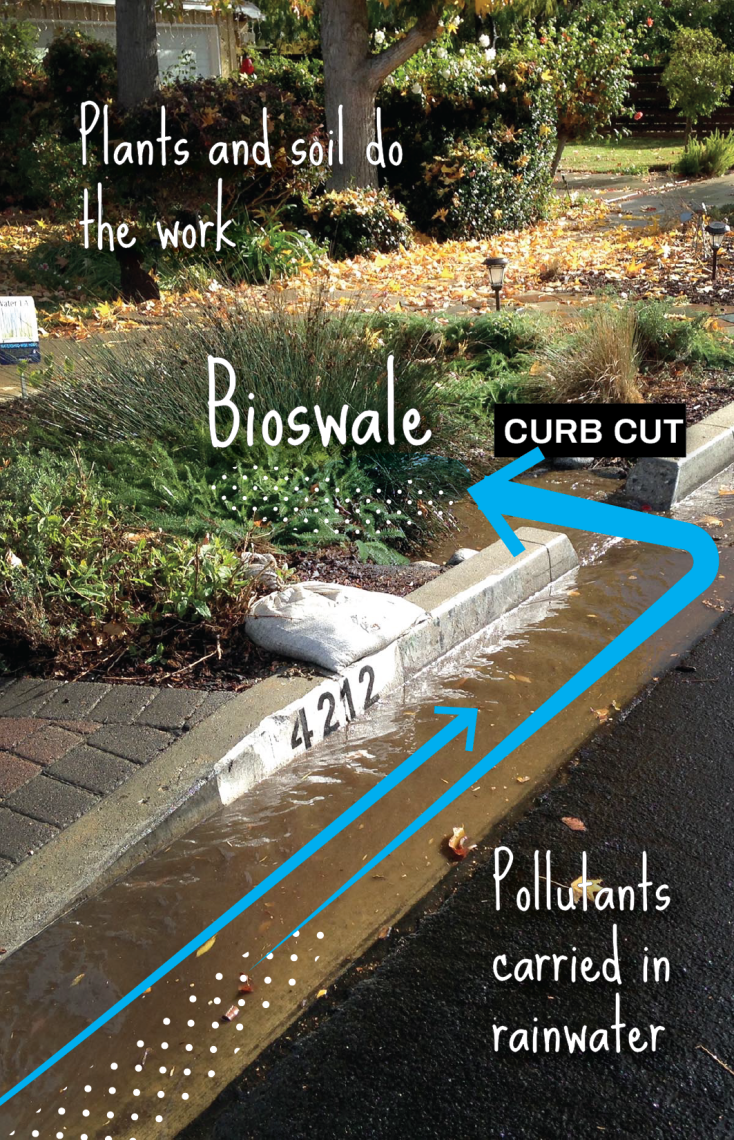
Solutions Provided by Nature
Nature is good at making complexity simple. For example, a single tree does extraordinary work. The leaf canopy exhales oxygen and filters particulate pollution from the air. The same canopy not only provides shade to the surrounding environment, but also air conditioning (through evapotranspiration). Leaf drop builds top soil and prevents erosion. Roots hold together slopes and facilitate the passage of rainwater deep into the ground. Tissues sequester carbon and convert pollutants into safe compounds. These same tissues can also provide building materials for humans, and food for insects and habitat and nesting sites for birds that all do work of their own. A tree can even self-heal from damage, and reproduces itself. A tree can do all of this and more while looking good. We have yet to invent any technology that can accomplish so much!
One could make a similarly long list of tasks accomplished by soil itself, which many think as being inert, but which actually supports entire ecosystems in itself, filters water, breaks down pollutants, and houses communities of microorganisms upon which our entire food web depends. We have even learned that the world’s soil holds more than three times the total amount of carbon as is held in the atmosphere and more than four times the carbon stored in all the planet’s living plant and animals! [i]
Urban development over the last century has privileged building new roads and buildings over allowing space for natural systems to continue functioning. We have replaced soil and plants with hard surfaces impermeable to the rain. A network of underground drainage pipes totalling 1,248 miles in length was engineered and installed—all to replace the basic functions of soil in absorbing the same amount of water that used to fall on a fully vegetated landscape. By bypassing soil on this journey, rainwater is no longer filtered before reaching the ocean. Instead, it picks up pollutants from our streets and conveys them directly into the ocean. Soil in urban environments is treated an inert with few uses. Meanwhile, the centralized and engineered treatment facilities that attempt to clean stormwater of contaminants before reaching the ocean cost us billions of dollars. Much of this filtering function was once provided by soil… for free.
As we build our knowledge about the world, we also build our ability to understand, appreciate, and incorporate more dynamic features with more consistent outcomes. From the IPCC and IPBES we understand that today humans are impacting the planet on a global scale. At the same time, we learn about how globally soil has more than three times the carbon in the atmosphere [Rattan 2007], how effective microorganisms can be at cleaning pollutants, how much water soil can filter and absorb, how trees and other plants can collectively reduce temperature, and how people feel better [Kaplan & Kaplan 1998, Herzog et al 2002, 2003], learn and focus more effectively [Chawla et al. 2014], recover faster [Ulrich 1984, Herzog 1997], and work together better around nature. We also learn how to design and organize so that more nature can be included.
what is gi revised 01
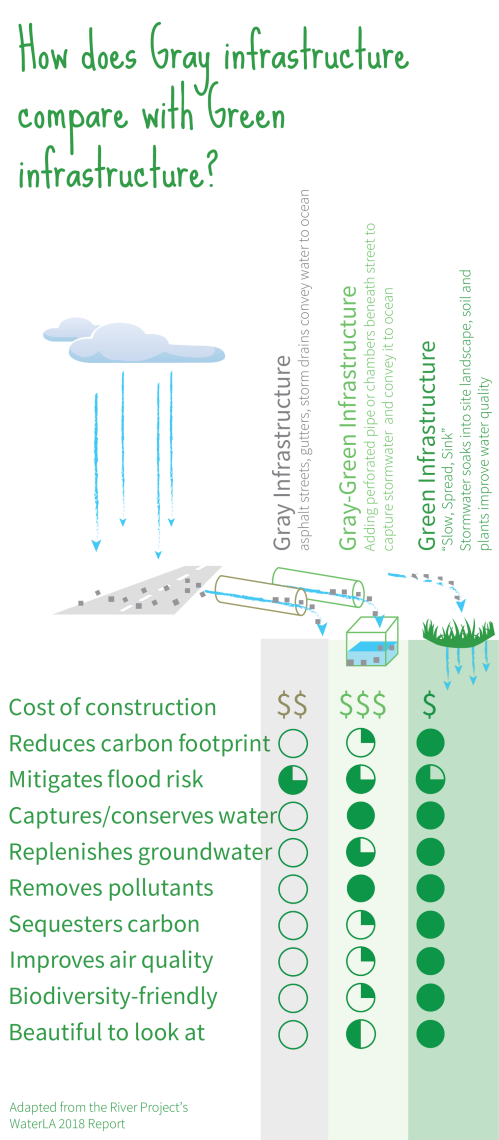
Green Infrastructure in the Los Angeles Basin
The idea that nature provides important ecosystem services we depend on is not new. Rivers have provided water, recreation, and other essential services in the basin for thousands of years. The Los Angeles region grew to fame as garden cities, and people have long gone into nature for health. The Angeles National Forest itself is green infrastructure that was intentionally conserved as a water resource over a hundred years ago, but at the same time the forest lands are an essential collector of water, they are also a water filter, air filter, air generator, absorber of carbon, home to important and endemic species, a source of activity and recreation important for the economy and wellbeing of countless people over generations, and much more.
The Gateway Cities does not have such vast spaces to leave nature to its own devices. However, there are ways parts of nature can be included and even drive important services. Exposed soil everywhere is full of life working hard to suck up water, carbon, and pollutants reducing flooding and improving air and water quality. Mulch makes these functions work better, holds more moisture, helps to manage weed growth, and plants and trees can make these functions even more effective. Grading the earth is a cost-effective way to catch even more rain water and runoff anywhere there is space, which can also mean watering significantly less. Even more water runoff can be pulled off the street and over plants and into the soil by cutting curbs and grading along streets. Parks, yards, and street parkways and medians can be planted with more diverse native plants adapted to the climate and supporting their own pest management. Green roofs can be effective in coastal areas where there is less evaporation, and permeable paving can support some microbial activity and water management where paving is needed.
ggp detail vert
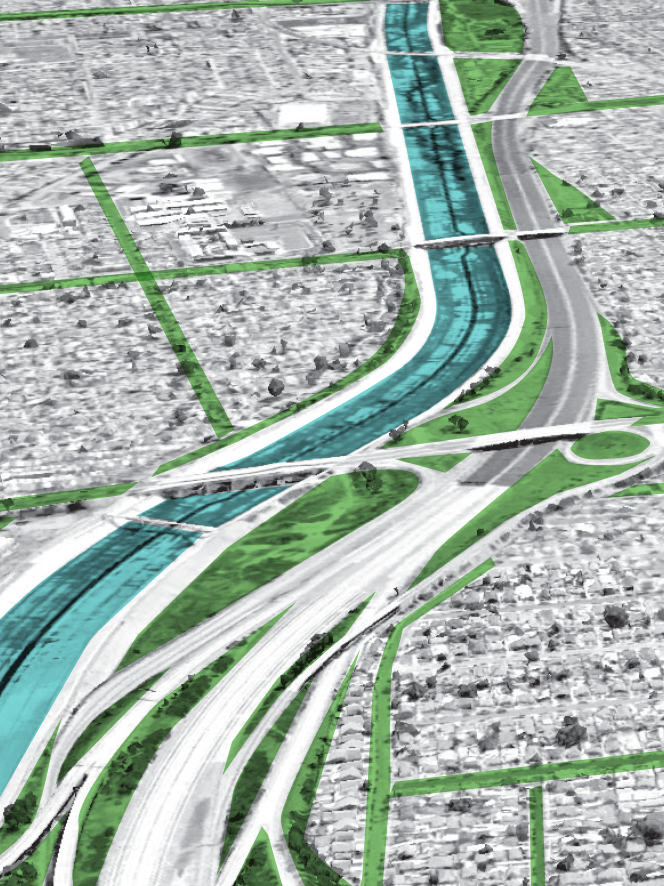
Benefits of Green Infrastructure and Nature-Based Solutions
Green infrastructure has been found to be 3 to 6 times more effective in managing storm-water per $1,000 invested than conventional methods [i]. Depending on scale, typology, and the benefits weighed, green infrastructure can be more cost-effective over time, compared against gray infrastructure[ii] .
Many methods and strategies are being applied and improved. However, most urban areas have been developed step by step with solutions to single challenges. Impermeable paving for streets. Gutters to drain water. Pipes to drain gutters into rivers. Filters for drains to help keep trash out of the ocean. These solutions to single challenges are also known as 'Grey Infrastructure' to compare with 'Green Infrastructure'. Green Infrastructure can be further broken into 'Grey-Green Infrastructure' and 'Nature-Based Solutions' to differentiate the design complexity and extent to which nature is designed to perform key functions.
Green infrastructure can complement conventional grey infrastructure projects (see table). Green infrastructure projects perform critical work, and collectively small projects distributed throughout a watershed can also help to reduce the load on grey infrastructure treatment plants and flood control facilities, enabling smaller and cheaper solutions to take the place of more costly ones.
A major consideration for designers and planners in selecting approaches is the range of benefits being considered. The inert materials of grey infrastructure may be more consistent and simple to quantify, and there are well established conventions. However, green infrastructure may address multiple environmental issues at once within the same footprint, including cleaning water and air, increasing local water supply, improving quality of life, offering shade and reducing urban heat, soil building, carbon storage, creating green jobs, and increasing pollinator habitat. Grey-green infrastructure can provide more benefits to grey infrastructure projects, and nature-based solutions can offer the most simple interventions that are designed to facilitate nature doing most of the work.
This vision plan shows examples of Gateway Cities landscapes in which a basic repertoire of green infrastructure strategies not only improves water quality in our rivers and streams, but can also bring other benefits to communities, such as shade, parks, locally produced food and spaces for community life. We hope this vision plan inspires dialogue about local opportunities to improve water quality while also bringing a wider range of benefits of green infrastructure to our urban public spaces.
gi v grey trp chart with title
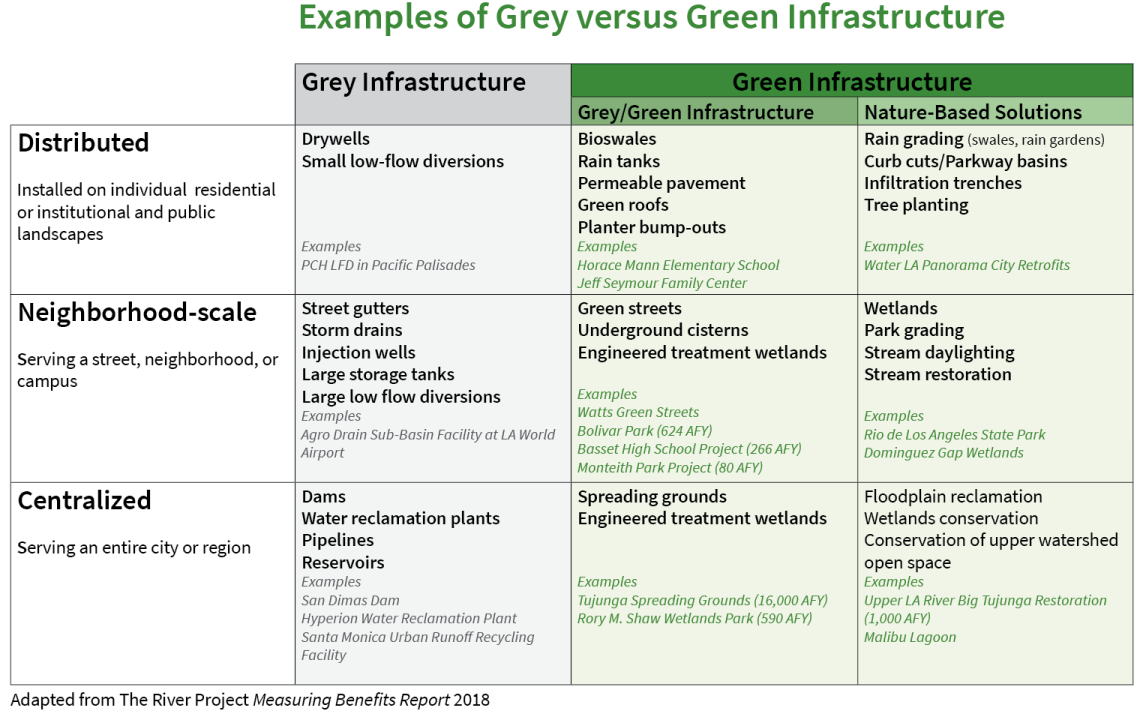
What is the cost of green infrastructure?
How does green infrastructure compare to traditional ‘grey’ infrastructure in terms of cost?
Soil, trees, and plants improve function over time, where inert materials such as pipes, filters, and concrete will have less initial maintenance costs but will have diminishing returns with finite lifespans. Wrapped into existing operations costs by property and street, significant savings can be realized. It is important to remember that large scale and centralized new projects typically are larger investments that may also have additional undesirable impacts such as traffic.
Considering a broad range of project types from dams to parcel-scale, The Pacific Institute (Cooley and Phurisamban 2016) found the most cost-effective projects for water conservation across California have been turf removal projects. The River Project Water LA Report (2018) also found minor grading (making simple rain gardens) with hand tools for stormwater capture to be the easiest and most cost-effective of residential property interventions for water management, as compared with rain tanks, greywater, permeable paving, infiltration trenches, and parkway retrofits. Rebate programs and regular operations grading earth with hand tools across all land uses can scale up with minimal cost for significant impacts.
When comparing the cost of green to grey infrastructure, it is important to factor in the multiple esthetic, public health, and environmental benefits of a well designed green infrastructure project. The City of Philadelphia found that the value of green infrastructure for stormwater management ranged from $1.94 to 4.47 billion over a 40-year period, as compared with $0.06 to $0.14 billion for grey infrastructure alternatives alone (Stratus 2009). Benefits included water quality improvements as well as recreation, aesthetics for land value, urban cooling, wetland creation, jobs, energy efficiency, air-related health impacts, and traffic impacts.
How do soil and plants clean water?
In stating that soil and plants treat water, that is only referring to the parts of a complex living ecosystem that are easiest to see and name.
At the most basic level, soil particles act as a filter, retaining solid particles and pollutants while letting water pass through. Other pollutants may be attracted to and retained by soil particles because of their electric charge.
Plants drop leaves which turn into mulch, and their root systems slough off cells, supplying soil with organic matter, increasing soils' ability to store water, carbon, and nutrients. At the same time, their roots break up hard soil, creating paths for water to sink deeper into the ground.
However, it is the communities of diverse microorganisms that live in soil, and which live in symbiotic connection with plant roots, which drive the cycles of nature that are the heart of green infrastructure. Microorganisms that live in soil transform and decompose some pollutants, such as fertilizers and hydrocarbons from oil derivatives, into other more benign substances. Mycorrhizal fungi, which are supported by nutrients secreted by plant roots, form networks that extend the roots of individual plants into an underground network that connects plants, shares nutrients, and water.
“Natural soils are thriving with life. They contain an incredible diversity of microscopic bacteria, fungi, viruses and other organisms. A single handful of soil can contain tens of thousands of different species. These microbes interact closely with each other, forming complex networks. They communicate with chemical signals. They work together to break down complex organic materials, including dead plants and animals. They often work in teams to complete biochemical processes, such as transforming nitrogen from an inert gas to plant-usable forms, and recycling it from dead plant materials back into dissolved forms.“ [i]
Healthy soils are a living material. Living soils are more fertile, support a diversity of microbial life, and store more moisture. Healthy soils increase resilience to drought and flood.[ii]
Urban soils are often compacted from our use of the land, such as driving over it with cars, moving it from other locations, and soil disturbance. Such “dirt” is less able to capture water or support life as easily as healthy soil.
We can build soil by planting it, and allowing organic matter to form a layer of mulch on it. The mulch will decompose and supply nutrients to the communities of soil microorganisms that turn soil into a living material. Building healthy soils will eventually enable the soil to capture more water and support healthier ecosystems. Moreover, soil building is a carbon sequestration strategy that can contribute to ameliorating climate change. More carbon is stored in soil on earth, than all the plants and the earth’s atmosphere combined.[iii]
Soil and plants are the basic components of green infrastructure. However, the life within them that soil and plants harbor and build over time is the true heart of green infrastructure
cjmmog399014b1qpe5lzs9b1w pc basin mammoth ceja1 2014 manip one half crop
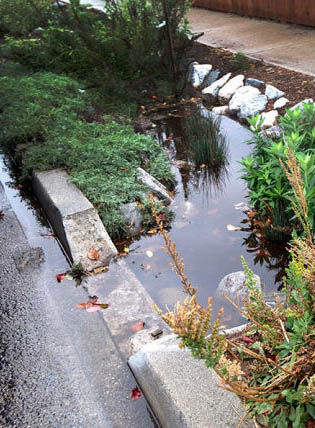
Sources
American Rivers, American Society of Landscape Architects, Water Environment Federation. (2012). Banking on Green: A Look at How Green Infrastructure Can Save Municipalities Money and Provide Economic Benefits Community-wide.
Chawla, L., Keena, K., Pevec, I., Stanley, E.. 2014. Green Schoolyards as Havens from Stress and Resources for Resilience in Childhood and Adolescence. Health & Place Vol 28.
Herzog, T. R., Black, A. M., Fountaine, K. A., & Knotts, D. J. 1997. “Reflection and Attentional Recovery as Distinctive Benefits of Restorative Environments.” Journal of Environmental Psychology, 17(2), 165–170.
Herzog, T. R., Chen, H. C., & Primeau, J. S. 2002. “Perception of the Restorative Potential of Natural and Other Settings.” Journal of Environmental Psychology, 22(3), 295–306.
Herzog, T. R., Colleen, Maguire, P., & Nebel, M. B. 2003. “Assessing the restorative components of environments.” Journal of Environmental Psychology, 23(2), 159–170.
Kaplan, R., Kaplan, S., & Ryan, R. L. 1998. With people in mind: design and management of everyday nature. Washington, DC: Island Press.
Lal, R. 2007. Carbon Sequestration. Philosophical Transactions of the Royal Society B Biological Sciences. The Royal Society.
Lal, R. 2007. Soil Carbon Sequestration Impacts on Global Climate Change and Food Security.
The River Project. 2018. Water LA 2018 Report.
The River Project. 2018. Measuring the Benefits of Distributed, Nature-Based Stormwater Projects.
Soil Carbon Storage. Climatenexus. downloaded 2018-09-12
Soil Science Society of America. 2015. Soils Sustain Life! A Soils Overview.
Tallamy, D. 2007. Bringing Nature Home. Portland, OR: Timber Press.
Wallenstein, M. (2017). To restore our soils, feed the microbes. The Conversation.
Water and People: An ‘Our County’ Workshop. Presentation of the Los Angeles County Sustainability Plan. July 23, 2018 at La Kretz Innovation Campus. Stormwater reduction could be further increased by expanding the ordinance "to include resale, and by establishing partnerships with NGOs to increase voluntary implementation."
Wolch, J., T. Longcore, J. Devinny, and J.P. Wilson. Green Visions Plan for 21st Century Southern California: A Guide for Habitat Conservation, Watershed Health, and Recreational Open Space. 1. Analytic Frameworks for the Green Visions Plan. University of Southern California GIS Research Laboratory and Center for Sustainable Cities, Los Angeles, California.
Ulrich, R. S. (1984). “View through a window may influence recovery from surgery.” Science, 224(4647), 420–421. doi:10.1126/science.6143402
US Environmental Protection Agency (EPA). 2016. “What is Green Infrastructure?”
Other Resources
The City of Los Angeles has implemented a Low Impact Development Ordinance for all development and redevelopment requiring permits. See their handbook and approved plans.
Watershed Management Group (WMG) in Tucson
Made with ❤️ by TreeStack.io
